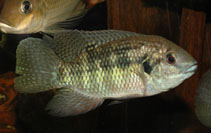| Family: |
Cichlidae (Cichlids), subfamily: Pseudocrenilabrinae |
| Max. size: |
11.6 cm SL (male/unsexed) |
| Environment: |
demersal; freshwater, |
| Distribution: |
Africa: present in the Kouilou-Niari, Loeme and Ddjoungou rivers in Republic of Congo, the Ogooué basin in Gabon (Ref. 81620) and in the middle Congo River basin between Kinshasa and Yangambi, including the drainages of the Dja, Ruki, Kasai (Ref. 52307), Lake Tumba (Ref. 41580), Lomami (Ref. 106245) and Itimbiri (Ref. 106290). Also reported from the lower Congo (Ref. 94750).
|
| Diagnosis: |
Dorsal spines (total): 14-15; Dorsal soft rays (total): 10-11; Anal spines: 3-3; Anal soft rays: 8-10. Diagnosis: rather deep-bodied (40.0-47.0% SL), greatest depth well behind dorsal fin origin; head moderately large (length 34.0-37.2% SL); wide interorbital (33.5-41% HL); mouth terminal and small; jaws (specimens >60 mm SL) with outer row teeth evenly spaced conical, unicuspid, 2-4 rows of smaller unicuspid inner teeth; smaller individuals often with some shouldered unicuspid or bicuspid teeth in jaws; caudal peduncle short and deep (Ref. 81260). Soft dorsal and anal fins produced in adults, extending well over caudal fin in males (Ref. 52307, 81260). Caudal fin truncate and heavily scaled over base; 3.5-4 scales between upper lateral line and dorsal fin origin; lanceolate epibranchial rakers; tips of pelvic fins in males reach well beyond the spinous anal fin (Ref. 81260).
Description: frontal profile straight; snout relatively short (Ref. 52307).
Coloration: live color of specimens from Democratic Republic of Congo (vicinity of Kinshasa): base body coloration of pale yellowish gold with metallic green iridescent spotting on scales of cheek and anteroventral flank; well-developed supraorbital, interorbital and internasal stripes; opercular spot extremely well-developed, in mid-line series with a row of 6 black blotches and faint vertical stripes; a second row of smaller blotches in a diffuse horizontal band is frequently present between mid-line row and dorsal fin base; Pelmatochromis spot at base of first 5-6 dorsal rays extends down onto dorsum in females and juveniles, slightly less well marked in large males; dorsal, caudal and anal fins with rows of dark maculae, proximally in anal fin these are often deep red (Ref. 81260). |
| Biology: |
Open substratum spawner (Ref. 52307). |
| IUCN Red List Status: |
Least Concern (LC); Date assessed: 16 February 2009 Ref. (130435)
|
| Threat to humans: |
harmless |
Source and more info: www.fishbase.org. For personal, classroom, and other internal use only. Not for publication.

